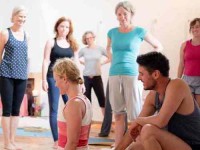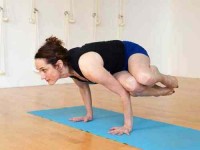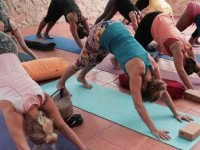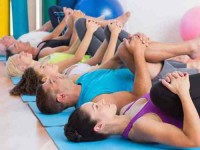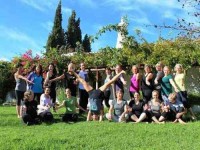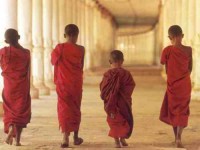Iyengar Yoga
Iyengar Yoga, named after and developed by B. K. S. Iyengar, is a form of Hatha Yoga that has an emphasis on detail, precision and alignment in the performance of posture (asana) and breath control (pranayama). The development of strength, mobility and stability is gained through the asanas.
B.K.S. Iyengar has systematised over 200 classical yoga poses and 14 different types of Pranayama (with variations of many of them) ranging from the basic to advanced. This helps ensure that students progress gradually by moving from simple poses to more complex ones and develop their mind, body and spirit through a step-by-step approach.
Iyengar Yoga often makes use of props, such as belts, blocks, and blankets, as aids in performing asanas (postures). The props enable students to perform the asanas correctly, minimising the risk of injury or strain, and making the postures accessible to both young and old.
Iyengar Yoga is firmly based on the traditional eight limbs of yoga as expounded by Patanjali in his Yoga Sutras.[citation needed]
Iyengar Yoga is a form of Hatha Yoga in which there is a focus on the structural alignment of the physical body through the development of asanas. Through the practice of a system of asanas, it aims to unite the body, mind and spirit for health and well-being. The discipline is considered by its practitioners to be a powerful tool to relieve the stresses of modern-day life, in turn helping to promote total physical and spiritual well-being.
It can be said that Iyengar differs from the other styles of yoga by three key elements: technique, sequence and timing.
- Technique refers to the precision of the body alignment and the performance of pranayama.
- Sequence means the sequences in which asanas and breathing exercises are practiced. Following the specific sequence is important in achieving the desired result, because only the combination of certain poses and breathing techniques can ensure the expected positive effect.
- Timing is the third key element which defines the time spent in each pose or pranayama.
Iyengar Yoga is characterized by great attention to detail and precise focus on body alignment. Iyengar pioneered the use of "props" such as cushions, benches, blocks, straps and sand bags, which function as aids allowing beginners to experience asanas more easily and fully than might otherwise be possible without several years of practice. Props also allow elderly, injured, tired or ill students to enjoy the benefits of many asanas via fully "supported" methods requiring less muscular effort.
Unlike more experiential approaches where students are encouraged to independently "find their way" to the asanas by imitating the teacher, an Iyengar Yoga class is highly verbal and precise, with misalignments and errors actively corrected. Iyengar teachers complete at least two years of rigorous training for the introductory certificate. They may complete subsequent intermediate levels and senior levels of certification, potentially entailing a decade or more of training.
Direction was named after BKS Iyengar, modern yoga master, who lives in India, Pune. Iyengar has created a system of physical development of the person, which was transferred to the West in the 60s of the last century and adapted for the Europeans. As a young Iyengar preferred dynamic and hard practice, aimed at strengthening the body -imenno as his mentor T. Krishnamacharya taught the young aristocrats of the military class (another disciple of Krishnamacharya - Patabhi Joyce - became the successor of this method, which was later called Ashtanga Vinyasa yoga). Over time, however, realizing that such a practice is effective only for the young and healthy people, Iyengar began to pay more attention to the profound and subtle work in the pose and the therapeutic effects of the asanas.
FEATURES OF THE METHOD
- Static performance of asanas using various devices (blocks, belts, rollers, chairs, blankets, etc.).
- Development of the practice comes from the simple to the complex.First, focus on standing poses. posture fixing time gradually increased, allowing the practitioner to penetrate consciousness into every part of the body and be aware of the internal movement. The therapeutic effect of the asanas with the increases. Typically, sessions on standing postures, slopes, deflections, balance and twisting, alternate. Much attention is also paid to the inverted postures. Iyengar points out the need for a uniform extension of the body in any asana.
- Detailed and detailed explanation of each pose.
EFFECT
During practice the body becomes strong, flexible and balanced. The concept of body alignment in a pose - one of the key in Iyengar yoga. By aligning the body on a physical level, we provoke changes in the energy level, which has an impact on the psycho-emotional state, consciousness and mind.
THIS APPROACH
This area is considered to be universal. Due to all kinds of adaptations, Iyengar method is suitable for men and women regardless of their age, health status and origin. So it is, however, to avoid injury still should begin practice under the supervision of an experienced instructor.
THIS WILL NOT WORK
Impatient, energetic people at the stage of detuning rigorous asanas can be difficult to focus. Excessive activity of the person at risk to get bored at the very beginning and, disappointed in yoga and do not find the treasure in it.
- Anusara Yoga
- Aqua yoga
- Ashtanga Yoga
- Ayurveda Yoga
- Bhakti Yoga
- Bihar Yoga
- Bikram / Hot Yoga
- Dynamic Yoga
- Hatha Yoga
- Himalayan yoga
- Hridaya yoga
- Integral yoga
- Iyengar Yoga
- Jivamukti Yoga
- Kripalu Yoga
- Kriya Yoga
- Kundalini Yoga
- NEW INDIA
- Nidra Yoga
- Power Yoga
- Restorative Yoga
- Sivananda Yoga
- Tantra Yoga
- Taoist yoga
- Vinyasa Yoga
- Yin Yoga
- Yoga flow
- All yoga retreats
- DESTINATION: India +
- Costa Rica
- Greece
- Indonesia
- Italy
- Mexico
- Morocco
- Portugal
- Spain
- Thailand
- Turkey
- USA


